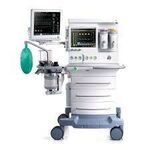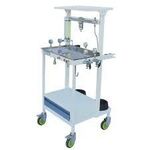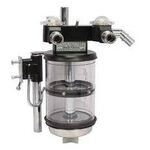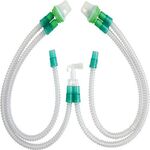Anesthesia Machine
An anesthesia machine, also known as an anesthesia workstation, that helps doctors give anesthesia to patients during surgery.
It works by mixing oxygen with anesthetic gases and sending them to the patient through a mask or breathing tube.
There are different types such as:
- Portable anesthesia machines
- Stationary machines
- Computerized or advanced machines
What is an Anesthesia Machine?
An anesthesia machine is an Anesthesiology Equipment that helps doctors give anesthesia to patients during surgery. It makes sure the patient stays unconscious, doesn’t feel pain, and breathes safely while the operation is going on.
This machine mixes gases: like oxygen and anesthetic gas, and sends them to the patient through a mask or breathing tube. It also keeps track of how the patient is breathing.
An anesthesia machine is very important in surgeries because it helps patients sleep safely and pain-free while doctors do their work.
How Does the Anesthesia Machine Work?
An anesthesia machine mixes oxygen and anesthesia gas and sends it to the patient through a mask or tube.
It helps the patient stay unconscious and pain-free during surgery.
The machine also supports breathing if needed.
It shows important readings like oxygen levels and pressure.
This keeps the patient safe while doctors operate.
Different Parts of Anesthesia Machine:
An anesthesia machine is made up of many important parts that work together. Each part does a different work to help deliver anesthesia, support breathing, and monitor the patient's condition.
Here are the main parts:
1. Gas Supply System:
This part connects to gas cylinders. It supplies oxygen, nitrous oxide, and other gases used during anesthesia.
2. Vaporizers:
Vaporizers turn liquid anesthesia into gas form. The patient then inhales these gases to stay unconscious and pain-free. Vaporizers are built for safety and precise control of anesthesia levels.
This device helps the patient breathe during surgery. It pushes air into the lungs and removes carbon dioxide, especially when the patient cannot breathe on their own.
4. Monitoring System:
This part includes digital screens that show vital signs like heart rate, blood pressure, oxygen levels, and breathing rate. It helps the doctor look the patient's condition in real-time.
What are the Main Uses of Anesthesia Machine?
An anesthesia machine is one of the most important machines in an operation theater. It is used by anesthesiologists.
Here are the main uses of this advanced machine:
To Deliver Anesthesia Gases
To Support Breathing
To Monitor the Patient's Vital Signs
To Maintain a Safe Surgical Environment
What is the Function of Anesthesia Machine?
An anesthesia machine administers a controlled mix of anesthetic agents and oxygen to keep the patient unconscious and relaxed.
The anesthesia machine assists or completely controls the patient’s breathing using a built-in ventilator, especially during long surgeries.
It continuously monitors vital signs like oxygen saturation, carbon dioxide levels, and respiratory rate to ensure patient safety.
This machine precisely mixes oxygen and other medical gases with anesthetic agents and controls their flow to maintain appropriate dosage.
An anesthesia machine is equipped with alarms, oxygen bypass systems, and backup oxygen supplies to handle critical situations.
What are the Features of Anesthesia Machine?
An anesthesia machine is equipped with advanced features to safely deliver anesthetic gases:
Gas Delivery System:
An anesthesia machine ensures a controlled mix of oxygen, nitrous oxide to keep the patient unconscious and pain-free during surgery.
Ventilator for Breathing Support:
This machine includes a ventilator that assists or completely takes over the patient’s breathing, especially when they cannot breathe on their own.
Monitoring System:
They monitor vital parameters like heart rate, oxygen levels, and carbon dioxide levels, helping the surgical team track the patient’s condition in real time.
Backup Safety Mechanisms:
Modern anesthesia machines have alarms, oxygen bypass features, and battery backup to handle emergencies or system failures during surgery.
Compact and Portable Models:
Some anesthesia machines are designed to be compact and portable, making them suitable for use in smaller spaces or emergency settings.
Anesthesia Workstation vs. Anesthesia Machine:
Anesthesia Workstation and Anesthesia Machine are two terms often used in hospitals, but they are not exactly the same. While both are used to give anesthesia during surgeries, the anesthesia workstation is a more advanced and complete version of the anesthesia machine.
Anesthesia Machine:
An anesthesia machine is a basic device that delivers a controlled mix of gases like oxygen and anesthesia to the patient. It includes a gas supply system, vaporizers, flow meters, and a breathing system. These machines are mostly manual or semi-automatic and are often used in places with limited resources. They do the core job of giving anesthesia, but may require separate equipment for monitoring or ventilation.
Anesthesia Workstation:
An anesthesia workstation is a modern, fully integrated system that combines the anesthesia machine with many other advanced features. It usually includes a built-in ventilator, multiple gas monitoring systems, patient monitoring tools (like ECG, SpO₂, and blood pressure), and safety alarms. Everything is controlled from a digital screen, and many settings are automated. It offers more precision, safety, and convenience, especially in high-risk or long surgeries.
Main Differences:
- Anesthesia Workstation is digital and advanced; Anesthesia Machine is more basic.
- Anesthesia Workstation includes monitoring and ventilation; Anesthesia Machine focuses on gas delivery.
- The Machine is used in smaller or low-resource settings; Anesthesia Workstation is common in modern operating rooms.
Overview of Anesthesia Machine Price:
Anesthesia Machine Price starts from INR 60,000 to INR 1200,000 depending on types and brands.
Here is the list of Anesthesia Machine:
*Price may be subject to change.
Factors Affecting the Price of an Anesthesia Machine:
The price of an anesthesia machine can vary widely, depending on several important factors. Whether it's a basic model or an advanced one, the cost is influenced by the features, technology, and brand. Below are the key factors that affect its price:
1. Type of machine:
Basic machines with manual controls are more affordable. Fully digital or automatic machine with integrated ventilators and monitors are more expensive due to their advanced functions.
2. Built-in Ventilator:
If the workstation includes a high-quality ventilator, the cost goes high. Ventilators that support different modes of breathing add to the price.
3. Monitoring System:
Machine with built-in patient monitors cost more than those that need separate monitoring equipment.
4. Brand and Manufacturer:
Well-known and trusted brands like GE, Comen, Mindray, Dräger usually cost more because of their reputation, quality.
Different Types of Anesthesia Machine:
An anesthesia machine comes in various types designed to suit different surgical settings, patient needs, and levels of mobility.
1. Anaesthesia Workstation:
An anesthesia workstation is a comprehensive machine with advanced features, including a ventilator, multiple gas delivery systems, and patient monitoring tools. It is primarily used in operating rooms for complex and long-duration surgeries, providing precise control and real-time patient data.
2. Portable Anesthesia Machine:
A portable anesthesia machine is lightweight and compact, ideal for emergency settings, mobile clinics, or smaller hospitals. It delivers basic anesthesia functions, making it a reliable option when mobility and convenience are essential.
3. Continuous Flow Anesthesia Machines:
Continuous flow anesthesia machines deliver a consistent mix of gases to the patient over a long period. These machines are used in surgeries requiring stable and uninterrupted anesthesia levels, ensuring patient safety and comfort.
Best Brands of Anesthesia Machine:
When choosing an anesthesia machine, top brands are recognized for their reliability, advanced technology, and safety features. Here are some of the best options:
1. Philips Anesthesia Machine:
Known for innovation, Philips anesthesia machines come with advanced monitoring systems and precise gas delivery technology. They are ideal for modern hospitals requiring integrated solutions for anesthesia and patient care.
2. Drager Anesthesia Machine:
Drager is a leader in anesthesia technology, offering robust machines with intuitive controls and efficient gas management systems. Their machines are highly trusted for both general and specialized surgeries worldwide.
3. GE Anesthesia Machine:
GE anesthesia machines are known for reliability, offering features like customizable ventilation modes and real-time patient monitoring. They are suitable for a wide range of surgical procedures, ensuring patient safety and comfort.
Things To Be Considered Before Buying an Anesthesia Machine:
Choosing the right anesthesia machine is crucial to ensure patient safety, reliable performance, and compatibility with your surgical needs. Here are some key factors to keep in mind:
- Type of Anesthesia Machine
- Ventilation Features
- Gas Delivery and Control
- Monitoring Systems
- Ease of Use and Maintenance
- Waste Gas Scavenging
- Safety Features
- Brand and Support
Why Should You Buy Anesthesia Machine From Biomed Suppliers:
Biomed supplier offers a wide range of high-quality anesthesia machines at competitive prices. Here’s why it’s a great choice:
Extensive Selection of Brands: Biomed supplier provides access to top anesthesia machine brands like Philips, Drager, GE, Mindray, and Comen, ensuring you can choose the one that fits your needs best.
Competitive Pricing: We offer anesthesia machines at affordable rates with transparent pricing, making it easier to stay within your budget.
Detailed Product Information: Each anesthesia machine listing includes comprehensive specifications, features, and comparisons, helping you make an informed decision.
Customer Support: Biomed supplier offers excellent customer service to guide you through the buying process and answer any queries about anesthesia machines.
Frequently Asked Questions:
1. What is an anesthesia machine used for?
An anesthesia machine is used during surgeries to deliver a controlled mix of gases to keep the patient unconscious and pain-free, while also supporting their breathing.
2. How does an anesthesia machine work?
The anesthesia machine delivers a mixture of gases through a breathing circuit to the patient. It also includes a ventilator to assist or control the patient’s breathing and monitors vital parameters like oxygen levels and heart rate to ensure patient safety.
3. What types of anesthesia machines are available?
There are several types of anesthesia machines:
- Anesthesia Workstation: Ideal for complex surgeries in operating rooms.
- Portable Anesthesia Machine: Compact and mobile, suitable for emergency use or smaller facilities.
- Continuous Flow Anesthesia Machine: Delivers a steady flow of gases for long-duration surgeries.
4. How do you choose the right anesthesia machine?
Consider factors like the type of surgery, ventilation requirements, monitoring needs, and budget. A workstation might be best for advanced surgeries, while a portable model could suit smaller setups or emergencies.
5. What safety features should an anesthesia machine have?
Look for machines with safety features like alarms for low oxygen levels, backup oxygen supply, and fail-safe mechanisms to avoid gas flow interruptions during critical moments.
6. Can anesthesia machines be used for different types of surgeries?
Yes, anesthesia machines are versatile and can be used for various surgical procedures, ranging from routine operations to complex and critical surgeries, depending on the machine’s features and capabilities.
7. What maintenance is required for an anesthesia machine?
Regular maintenance includes checking gas cylinders, cleaning filters, calibrating monitors, and ensuring the ventilator and gas flow systems are functioning properly.
Popular Categories:
Anesthesiology Equipment | Portable Anaesthesia Machine | Laryngoscope | Pediatric Laryngoscope | Video Laryngoscope | laryngoscope Blade | Anesthesia Ventilator | Guedel Airway | Anesthesia Vaporizer | ECG Machine | Single Channel ECG Machine | 3 Channel ECG Machine | 6 Channel ECG Machine | 12 Channel ECG Machine | Ventilator Machine | ICU Ventilator | Oxygen Concentrator Machine | Portable Oxygen Concentrator | Home Oxygen Concentrator | Nebulizer Machine | ICU Ventilator | Dialysis Machine | DVT Pump | Defibrillator | AED Machine | Cardiac Monitor | Multipara Monitor | Pulse Oximeter | Patient Monitor | Fetal Monitor | BiPAP & CPAP Machine | Suction Machine | Patient Warmer | Autoclave Machine | X Ray Machine | CR & DR System | Ultrasound Machine | MRI Machine | CT Scan Machine | Littmann Stethoscope | TMT Machine | Holter Monitor | Spirometer Machine | Audiometer | EMG Machine | EEG Machine | Stretcher | Hospital Chair | Hospital Beds | Hospital Trolley | Biochemistry Analyzer | CBC Machine | Centrifuge Machine | Urine Analyzer | Lab Shakers and Rotators | ESR Analyzer | Surgical Microscope | ECG Paper | Insulin Pump | Syringe Pump | Feeding Pump | Oximeter | Stethoscope |





